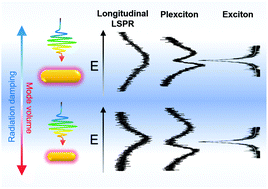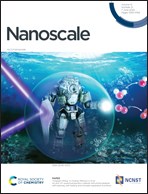Nanoscale plasmon–exciton interaction: the role of radiation damping and mode-volume in determining coupling strength†
Abstract
Unravelling the exact role of each individual plasmon decay channel in plasmon–exciton coupling is pivotal for successful realization of the exciting potential applications of plexcitonic nanostructures. Here, we successfully demonstrate how exactly one specific plasmon dephasing channel, radiation damping, influences plasmon–exciton coupling in Au nanorod-J-aggregate hybrids. We systematically and selectively varied the contribution of radiation damping, keeping the contributions of other damping channels negligible or invariant, by controllably varying nanorod diameter (above 20 nm) while maintaining the aspect ratio constant and studied the optical response of the corresponding plexcitons using single-particle spectroscopy. Our results show that decreasing radiation damping inversely drives the plasmon–exciton interaction toward a strong coupling regime. However, we find that plasmon mode-volume is a more fundamental parameter in dictating coupling strength than radiation damping. Overall, this comprehensive study provides a significant step toward developing a predictive understanding of how exactly excitation decay channels influence plasmon–exciton coupling.



 Please wait while we load your content...
Please wait while we load your content...